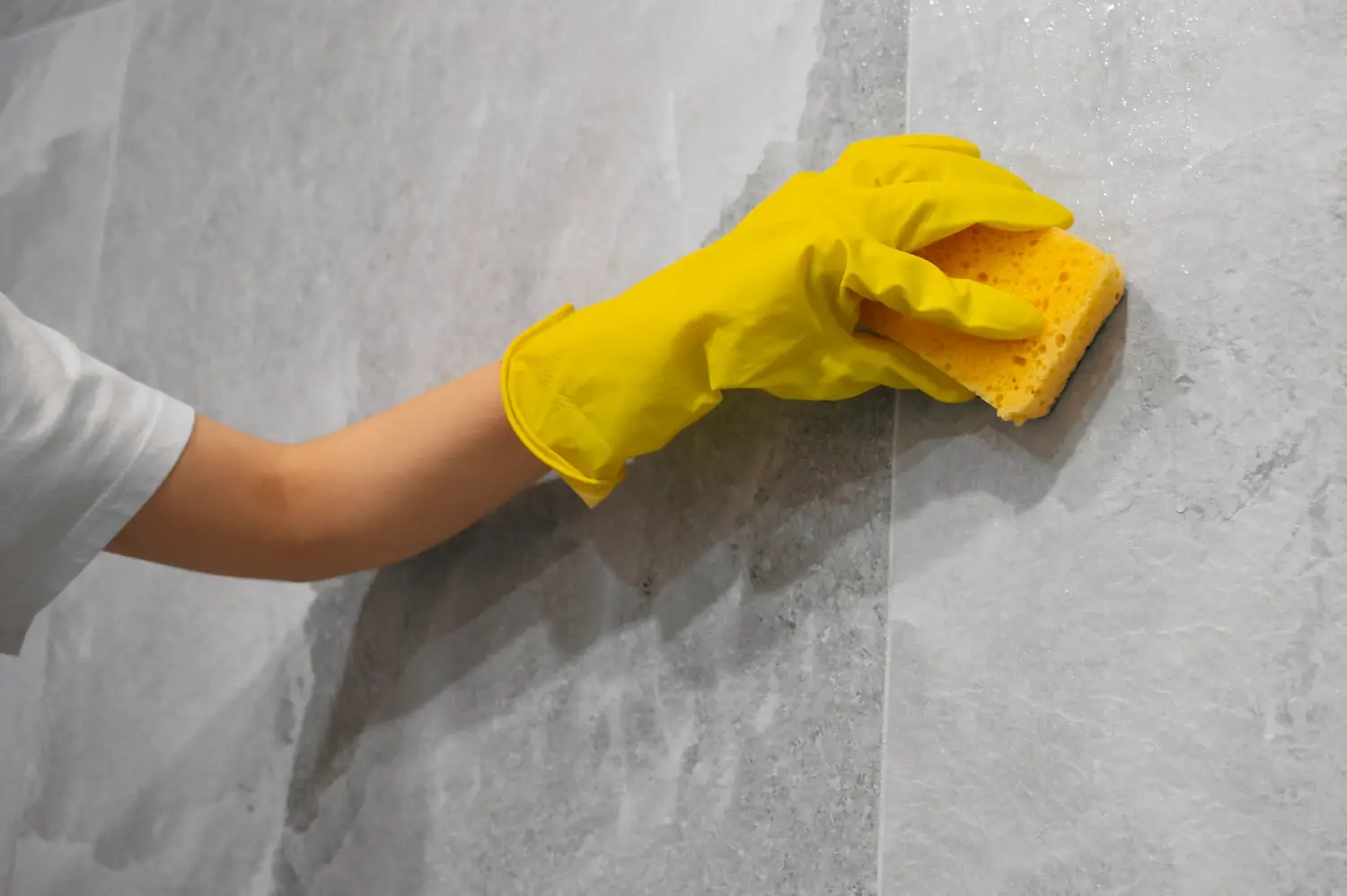Are you tired of looking at dirty and stained grout in your bathroom or kitchen? Don’t worry, we’ve got the solution for you! In this article, we will show you how to effectively seal and protect your grout, keeping it looking clean and new for years to come. Properly sealed grout not only enhances the appearance of your tile but also helps to prevent water damage and the growth of mold and mildew. Whether you’re a DIY enthusiast or a homeowner looking to tackle a small home improvement project, sealing and protecting grout is a simple and cost-effective way to maintain the beauty and durability of your tiled surfaces.
We will guide you through the entire process, from choosing the right sealer to preparing the grout and applying the sealer correctly. We will also provide you with some expert tips and tricks to ensure a smooth and hassle-free sealing experience. So, say goodbye to dull and dirty grout lines and say hello to sparkling, protected surfaces. Let’s dive in and learn how to seal and protect grout like a pro!
Need to clean your home or need grout cleaning? Get a quote >
Importance of Sealing and Protecting Grout
The first step in understanding how to seal and protect grout is to recognize the importance of this process. Unsealed grout is vulnerable to a variety of problems, such as staining, discoloration, and deterioration. Over time, water, dirt, and other contaminants can penetrate the porous surface of unsealed grout, causing it to become discolored and difficult to clean.
Sealing Grout
Sealing grout creates a protective barrier that prevents liquids and dirt from penetrating the surface. This not only helps to keep your grout looking clean and new but also extends its lifespan. Additionally, sealed grout is less prone to the growth of mold and mildew, which can lead to health issues and further damage to your tiles.
Properly sealed and protected grout not only enhances the aesthetic appeal of your tiled surfaces but also provides long-term durability and ease of maintenance. By investing a little time and effort into sealing your grout, you can enjoy beautiful, clean, and hygienic surfaces for years to come.
Common Problems with Unsealed Grout
Before we delve into the grout sealing process, let’s take a moment to understand the common problems associated with unsealed grout. Unsealed grout is susceptible to various issues that can compromise the appearance and integrity of your tiled surfaces.
Grout Stains
One of the most common problems is staining. Without a protective seal, grout absorbs liquids, such as water, oils, and dyes, which can result in unsightly stains that are difficult to remove. Stained grout not only looks unsightly but can also give the impression of poor maintenance.
Unsealed grout is also more prone to discoloration and fading. Over time, exposure to sunlight, cleaning chemicals, and foot traffic can cause the color of unsealed grout to fade or change, resulting in an uneven and worn-out appearance.
Water Damage
Furthermore, unsealed grout is highly susceptible to water damage. Moisture can penetrate the porous surface of the grout, leading to mold and mildew growth. This not only poses health risks but can also cause the grout to weaken and crumble over time.
By sealing and protecting your grout, you can avoid these common problems and ensure that your tiled surfaces remain clean, beautiful, and durable.
Understanding the Grout Sealing Process
Now that we understand the importance of sealing and protecting grout, let’s dive into the grout sealing process. While it may seem like a daunting task, sealing grout is actually quite simple and can be done by anyone, whether you’re a seasoned DIY enthusiast or a homeowner looking to tackle a small home improvement project.
Choose the Right Sealer
The first step in the grout sealing process is to choose the right sealer for your specific needs. There are various types of grout sealers available, including penetrating sealers, epoxy sealers, and topical sealers. Each type of sealer has its own advantages and considerations, so it’s important to understand the differences before making a decision.
Penetrating sealers are the most common type and are suitable for most grout applications. They penetrate the grout and create a protective barrier that repels liquids and dirt. Epoxy sealers, on the other hand, provide a more durable and stain-resistant finish but require more time and effort to apply. Topical sealers sit on the surface of the grout and provide a glossy or matte finish, depending on your preference.
Once you’ve chosen the right sealer, the next step is to prepare the grout for sealing. This involves thoroughly cleaning the grout lines to remove any dirt, debris, or existing stains. A mixture of warm water and mild detergent is usually sufficient for this step. It’s important to allow the grout to completely dry before proceeding to the next step.
Types of Grout Sealers
Now that we understand the importance of sealing and protecting grout, let’s dive into the grout sealing process. While it may seem like a daunting task, sealing grout is actually quite simple and can be done by anyone, whether you’re a seasoned DIY enthusiast or a homeowner looking to tackle a small home improvement project.
The first step in the grout sealing process is to choose the right sealer for your specific needs. There are various types of grout sealers available, including penetrating sealers, epoxy sealers, and topical sealers. Each type of sealer has its own advantages and considerations, so it’s important to understand the differences before making a decision.
Penetrating sealers are the most common type and are suitable for most grout applications. They penetrate the grout and create a protective barrier that repels liquids and dirt. Epoxy sealers, on the other hand, provide a more durable and stain-resistant finish but require more time and effort to apply. Topical sealers sit on the surface of the grout and provide a glossy or matte finish, depending on your preference.
Once you’ve chosen the right sealer, the next step is to prepare the grout for sealing. This involves thoroughly cleaning the grout lines to remove any dirt, debris, or existing stains. A mixture of warm water and mild detergent is usually sufficient for this step. It’s important to allow the grout to completely dry before proceeding to the next step.
Preparing the Grout for Sealing
Before applying the sealer, it’s crucial to properly prepare the grout to ensure optimal adhesion and effectiveness of the sealer. This step involves removing any existing dirt, debris, or stains that may interfere with the sealing process.
Start by cleaning the grout lines using a mixture of warm water and mild detergent. Use a scrub brush or a grout cleaning tool to agitate the surface and remove any stubborn stains. Pay special attention to high-traffic areas and areas that are more prone to dirt and grime buildup.
After cleaning the grout, rinse the surface thoroughly with clean water to remove any residue. It’s important to allow the grout to dry completely before applying the sealer. This may take a few hours or even overnight, depending on the temperature and humidity levels in your environment.
Applying the Grout Sealer
Once the grout is properly prepared, it’s time to apply the sealer. Before you begin, it’s important to read and follow the manufacturer’s instructions on the sealer packaging. Different sealers may have specific application methods and drying times, so it’s crucial to follow the guidelines for best results.
Start by pouring a small amount of sealer into a clean container or directly onto the grout lines. Use a clean brush or a sponge applicator to spread the sealer evenly over the grout. Work in small sections to ensure thorough coverage and to prevent the sealer from drying before it’s fully applied.
As you apply the sealer, make sure to remove any excess sealer from the tile surface. This can be done using a clean cloth or sponge. Excess sealer left on the tile surface can result in a hazy or sticky residue that is difficult to remove.
Once the sealer is applied, allow it to dry according to the manufacturer’s instructions. This may take several hours or even overnight, depending on the type of sealer and environmental conditions. It’s important to avoid any foot traffic or water exposure during the drying process to ensure optimal sealing results.
Maintaining and Cleaning Sealed Grout
Congratulations! You’ve successfully sealed your grout and protected your tiled surfaces. Now it’s time to learn how to properly maintain and clean sealed grout to ensure its longevity and beauty.
Regular maintenance is key to preserving the integrity of sealed grout. Start by sweeping or vacuuming the tiled surfaces regularly to remove any dirt, dust, or debris that may accumulate. This prevents the grout from becoming discolored or stained over time.
For routine cleaning, use a mild detergent mixed with warm water and a soft brush or mop to clean the sealed grout. Avoid using abrasive cleaners or scrub brushes, as they can damage the sealer and grout.
If you notice any stains or discoloration on the sealed grout, there are specific grout cleaners available that are safe to use on sealed surfaces. Follow the instructions provided with the grout cleaner to effectively remove stains without damaging the sealer.
DIY vs Professional Grout Sealing
Now that you have a good understanding of the grout sealing process and how to maintain sealed grout, you may be wondering whether it’s better to tackle this project yourself or hire a professional.
Sealing grout can be a DIY project for those who are comfortable with basic home improvement tasks. With the right tools and materials, sealing grout can be done effectively and cost-efficiently. However, it’s important to follow the manufacturer’s instructions and take your time to ensure proper application and sealing.
On the other hand, hiring a professional grout sealing service can save you time and ensure a flawless finish. Professionals have the experience, tools, and expertise to handle the entire sealing process efficiently and effectively. They can also provide additional services, such as grout cleaning and restoration, if needed.
When deciding whether to go the DIY route or hire a professional, consider your own skill level, available time, and budget. If you’re confident in your abilities and have the time to dedicate to the project, DIY sealing can be a rewarding and cost-effective option. However, if you prefer to leave it to the experts or have a large area to seal, hiring a professional can provide peace of mind and a professional finish.
Frequently Asked Questions About Grout Sealing
How often should I seal my grout?
The frequency of grout sealing depends on various factors, such as the type of sealer used, the amount of foot traffic, and the level of exposure to moisture. As a general rule of thumb, it’s recommended to reseal grout every 1-3 years.
Can I seal old grout?
Yes, you can seal old grout. However, it’s important to thoroughly clean the grout lines before applying the sealer to ensure optimal adhesion and effectiveness.
Can I change the color of my grout with a sealer?
Some sealers are available in different colors and can be used to enhance or change the color of grout. However, it’s important to test the sealer on a small, inconspicuous area before applying it to the entire grout surface.
Can I seal grout in wet areas, such as showers or outdoor patios?
Yes, there are sealers specifically designed for wet areas, such as showers and outdoor patios. These sealers provide enhanced water resistance and protection against moisture damage.
Can I seal grout on vertical surfaces, such as backsplashes or bathroom walls?
Yes, grout can be sealed on vertical surfaces. However, it’s important to use a sealer with a thicker consistency or a sealer specifically designed for vertical applications to prevent it from running or dripping.
Conclusion and Final Tips for Grout Maintenance
Sealing and protecting grout is a simple and cost-effective way to maintain the beauty and durability of your tiled surfaces. By creating a protective barrier, sealed grout remains clean, stain-free, and resistant to water damage and mold growth.
Remember to choose the right sealer for your specific needs and follow the manufacturer’s instructions for proper application. Prepare the grout thoroughly by cleaning it and allowing it to dry completely before applying the sealer. Once the sealer is applied, maintain and clean the sealed grout regularly to ensure its longevity and beauty.









